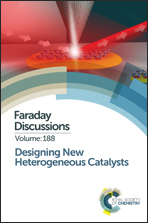Designing for selectivity: weak interactions and the competition for reactive sites on gold catalysts†
Abstract
A major challenge in heterogeneous catalysis is controlling reaction selectivity, especially in complex environments. When more than one species is present in the gas mixture, the competition for binding sites on the surface of a catalyst is an important factor in determining reaction selectivity and activity. We establish an experimental hierarchy for the binding of a series of reaction intermediates on Au(111) and demonstrate that this hierarchy accounts for reaction selectivity on both the single crystal surface and under operating catalytic conditions at atmospheric pressure using a nanoporous Au catalyst. A partial set of measurements of relative binding has been measured by others on other catalyst materials, including Ag, Pd and metal oxide surfaces; a comparison demonstrates the generality of this concept and identifies differences in the trends. Theoretical calculations for a subset of reactants on Au(111) show that weak van der Waals interactions are key to predicting the hierarchy of binding strengths for alkoxides bound to Au(111). This hierarchy is key to the control of the selectivity for partial oxidation of alcohols to esters on both Au surfaces and under working catalytic conditions using nanoporous gold. The selectivity depends on the competition for active sites among key intermediates. New results probing the effect of fluorine substitution are also presented to extend the relation of reaction selectivity to the hierarchy of binding. Motivated by an interest in synthetic manipulation of fluorinated organics, we specifically investigated the influence of the –CF3 group on alcohol reactivity and selectivity. 2,2,2-Trifluoroethanol couples on O-covered Au(111) to yield CF3CH2O–C(![[double bond, length as m-dash]](https://www.rsc.org/images/entities/char_e001.gif) O)(CF3), but in the presence of methanol or ethanol it preferentially forms the respective 2,2,2-trifluoroethoxy-esters. The ester is not the dominant product in any of these cases, though, indicating that the rate of β-H elimination from adsorbed trifluoroethoxy is slower than that for either adsorbed methoxy or ethoxy, consistent with their relative estimated β-C–H bond strengths. The measured equilibrium constants for the competition for binding to the surface are 2.9 and 0.38 for ethanol and methanol, respectively, vs. 2,2,2-trifluoroethanol, indicating that the binding strength of 2,2,2-trifluoroethoxy is weaker than ethoxy, but stronger than methoxy. These results are consistent with weakening of the interactions between the surface and the alkyl group due to Pauli repulsion of the electron-rich CF3 group from the surface, which offsets the van der Waals attraction. These experiments provide guiding principles for understanding the effect of fluorination on heterogeneous synthesis and further demonstrate the key role of molecular structure in determining reaction selectivity.
O)(CF3), but in the presence of methanol or ethanol it preferentially forms the respective 2,2,2-trifluoroethoxy-esters. The ester is not the dominant product in any of these cases, though, indicating that the rate of β-H elimination from adsorbed trifluoroethoxy is slower than that for either adsorbed methoxy or ethoxy, consistent with their relative estimated β-C–H bond strengths. The measured equilibrium constants for the competition for binding to the surface are 2.9 and 0.38 for ethanol and methanol, respectively, vs. 2,2,2-trifluoroethanol, indicating that the binding strength of 2,2,2-trifluoroethoxy is weaker than ethoxy, but stronger than methoxy. These results are consistent with weakening of the interactions between the surface and the alkyl group due to Pauli repulsion of the electron-rich CF3 group from the surface, which offsets the van der Waals attraction. These experiments provide guiding principles for understanding the effect of fluorination on heterogeneous synthesis and further demonstrate the key role of molecular structure in determining reaction selectivity.
- This article is part of the themed collection: Designing New Heterogeneous Catalysts

 Please wait while we load your content...
Please wait while we load your content...